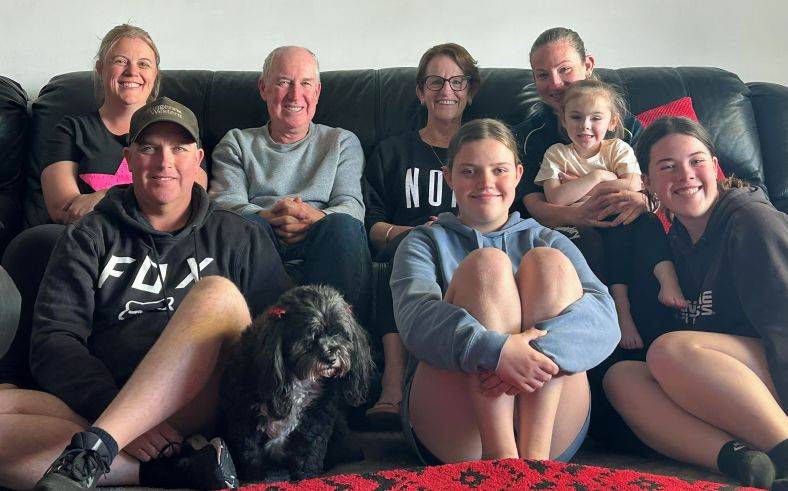With no previous warning signs, Lithgow local Vickie Anthes suffered a sudden and dangerous stroke that left her family and health care workers racing against the clock to save her.

Vickie and Don Anthes (back row centre) surrounded by their family at home in Lithgow.
“It was just a normal Sunday,” recalls Vickie’s husband Don.
“Vickie called out to me and when I got there, she was blank in the face. She was swaying and had trouble speaking, and her face had drooped a bit.”
A stroke occurs when a blood vessel supplying the brain either becomes blocked or ruptures, and the Australian Institute of Health and Welfare estimates there are more than one hundred stroke events every day across the country.
“I was sort of in panic mode first off, but I quickly got my senses together and recognised what was probably happening, and made the call to emergency services,” says Don.
Without the speedy response she received from family and health care workers, Vickie may not have been able to share her story of survival and recovery today.
“Here at the hospital, we are notified by the ambulance crew so we can be properly prepared, because with a stroke like Vickie’s every second counts,” says Chris Boothroyd, Clinical Nurse Consultant in Emergency at Blue Mountains and Lithgow Hospitals.
“If you don’t treat a stroke early then you can have permanent disability, or worse.”Chris Boothroyd, Clinical Nurse Consultant
“I feel very lucky”, says Vickie. “The ambulance responded really quickly and the response at Lithgow Hospital was absolutely amazing.”
Luck wasn’t the only thing on Vickie’s side though, as hospitals in the Blue Mountains and Lithgow have been rolling out life-saving new programs to treat stroke patients quicker and in a better coordinated way, including with more immediate access to the top specialists.
Thanks to Lithgow Hospital’s inclusion in the NSW Telestroke Service, staff could connect virtually with a network of specialist stroke doctors, resulting in Vickie’s rapid assessment, diagnosis, and treatment.
“In regional and rural locations, we’ve traditionally seen poorer outcomes for stroke patients due to our relative distance from the more specialist centres,” says Chris Boothroyd.
“Thanks to Telestroke, our local teams can now coordinate in real-time with the best experts available, no matter where they might be. It’s exciting that we have this resource at the bedside.”Chris Boothroyd, Clinical Nurse Consultant
“I don’t reckon Mum would be here now if it wasn’t for the new Telestroke system,” says Vickie’s daughter, Renee.
In addition to this increased level of coordination via Telehealth technology, East of Lithgow at Blue Mountains Hospital staff are further improving their approach to acute stroke presentations using Virtual Reality (VR).
The VR Acute Stroke Training Program allows nurses to get a simulated first-person perspective on managing a patient who arrives in the ED with stroke symptoms.
The training, currently underway at Blue Mountains Hospital in Katoomba, was developed through a partnership by the Agency for Clinical Innovation (ACI) and the Centre for Advanced Training Systems at the University of Newcastle, using a virtual reality platform called TACTICS VR.
Thanks to early and accurate intervention, Vickie is now back at home with her family, living life as before the stroke occurred.
“My recovery has been great,” says Vickie, who requires no ongoing treatment.
“I’m alive and I feel very grateful.”








